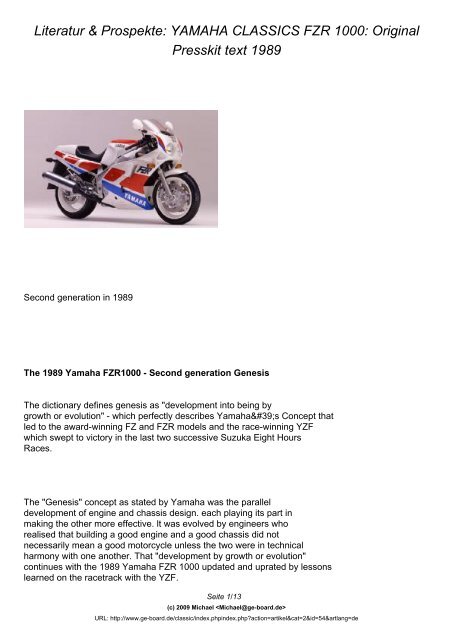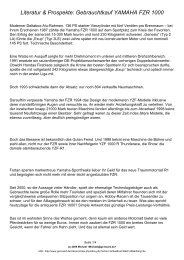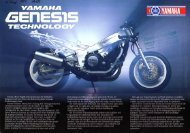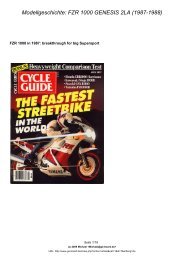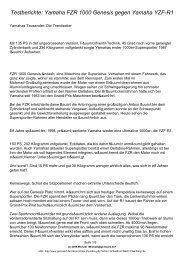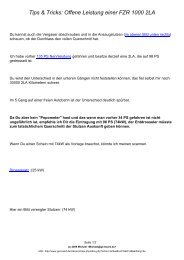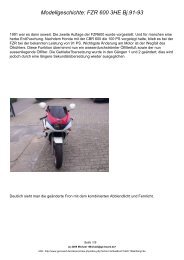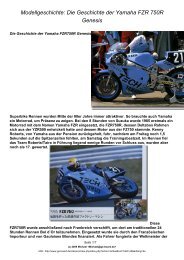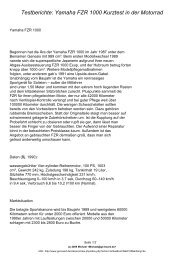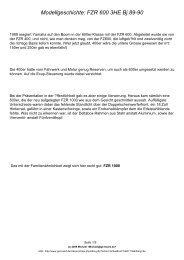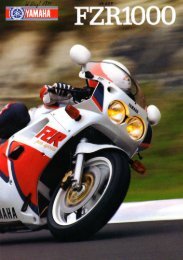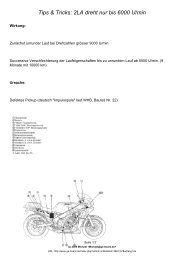YAMAHA CLASSICS FZR 1000: Original Presskit ... - GENESIS Board
YAMAHA CLASSICS FZR 1000: Original Presskit ... - GENESIS Board
YAMAHA CLASSICS FZR 1000: Original Presskit ... - GENESIS Board
Create successful ePaper yourself
Turn your PDF publications into a flip-book with our unique Google optimized e-Paper software.
Literatur & Prospekte: <strong>YAMAHA</strong> <strong>CLASSICS</strong> <strong>FZR</strong> <strong>1000</strong>: <strong>Original</strong><strong>Presskit</strong> text 1989Second generation in 1989The 1989 Yamaha <strong>FZR</strong><strong>1000</strong> - Second generation GenesisThe dictionary defines genesis as "development into being bygrowth or evolution" - which perfectly describes Yamaha's Concept thatled to the award-winning FZ and <strong>FZR</strong> models and the race-winning YZFwhich swept to victory in the last two successive Suzuka Eight HoursRaces.The "Genesis" concept as stated by Yamaha was the paralleldevelopment of engine and chassis design. each playing its part inmaking the other more effective. lt was evolved by engineers whorealised that building a good engine and a good chassis did notnecessarily mean a good motorcycle unless the two were in technicalharmony with one another. That "development by growth or evolution"continues with the 1989 Yamaha <strong>FZR</strong> <strong>1000</strong> updated and uprated by lessonslearned on the racetrack with the YZF.Seite 1/13(c) 2009 Michael URL: http://www.ge-board.de/classic/index.phpindex.php?action=artikel&cat=2&id=54&artlang=de
Literatur & Prospekte: <strong>YAMAHA</strong> <strong>CLASSICS</strong> <strong>FZR</strong> <strong>1000</strong>: <strong>Original</strong><strong>Presskit</strong> text 1989Featuring a new Deltabox frame, shorter and more compact dimensions,the remarkable EXUP exhaust power control system and improved enginedesign and performance, the latest evolution of the <strong>FZR</strong><strong>1000</strong> is the mostbalanced performer in the sportbike world.The original <strong>FZR</strong> <strong>1000</strong> won "Machine of the Year" awards from magazinereaders around the world as soon as it was announced. Yamaha areconfident that this "second generation Genesis" will be equally wellreceived. After all, it's the only sensible choice for those who demandthe very best.TECHNICAL HI-HLIGHTS· 1OO2cc, 4-stroke, 5-vaive, DOHC engine with liquid cooling· EXUP exhaust control system· FAI-air intake system· Transistor-controlled digital ignition· New aluminium Deltabox frame with increased rigidity· Preload adjustable front fork with rigid 43mm stanchions· Rising-rate Monocross rear Suspension with damping- and preload-adjustable shock absorber withreservoir· Aluminium Deltabox swingarm with YZF-type chain pullers· Hollow-spoke alloy wheels with wide radial tyres· Dual 320mm front disc brakes with 4-pot opposed-piston callipers using different sized pistons· 267mm rear disc brakeSeite 2/13(c) 2009 Michael URL: http://www.ge-board.de/classic/index.phpindex.php?action=artikel&cat=2&id=54&artlang=de
Literatur & Prospekte: <strong>YAMAHA</strong> <strong>CLASSICS</strong> <strong>FZR</strong> <strong>1000</strong>: <strong>Original</strong><strong>Presskit</strong> text 1989ENGINEWith its brilliant 5-valve cylinder head, slant block andefficient intake and exhaust systems. the <strong>FZR</strong> <strong>1000</strong> engine has anestablished place in motorcycling history. For 1989 it has beenimproved even further.A brief summary of the new engine's features are: a higher redlinethanks to a lighter valve train, more displacement (1002 cc). a highercompression ratio and redesigned combustion chamber with straighterintake ports. bigger carburettors, a reduction in frictional losseswith thinner rings, and the addition of the remarkable EXUP exhaustcontrol system. Now let's take a look at the details.The new engine has been shortened by 8mm. This was accomplished byshortening the length of the valves and lifters and using a newcamshaft case. The shorter valve stem length also allowed for a slightincrease in valve angle. The middle intake valve angle has increasedfrom 9 degrees to 10.5 degrees, the outer intakes from 17 to 18.5degrees, and the exhausts from 13 to 13.5 degrees. These more idealizedangles and the complementary improvements to port shapes increaseengine efficiency for higher power output. Other changes to the valvetrain include exhaust lifters increased in diameter from 20mm to 22.5mmfor improved reliability, and an overall reduction in valve weight,thanks to shorter sterns and a reduction in stern diameter from 5mm to4.5mm. This lighter valve train, combined with stiffer valve springs,permits a 500 mm higher redline and, consequently, more top-end power.Valve head diameter remains unchanged.An increase in bore from 75rnm to 75.Smm brings displacement up from989cc to 1002cc. Combined with reshaped combustion chamber and portsand slightly less dished pistons, this raises the compression ratioSeite 3/13(c) 2009 Michael URL: http://www.ge-board.de/classic/index.phpindex.php?action=artikel&cat=2&id=54&artlang=de
Literatur & Prospekte: <strong>YAMAHA</strong> <strong>CLASSICS</strong> <strong>FZR</strong> <strong>1000</strong>: <strong>Original</strong><strong>Presskit</strong> text 1989from 11.2: 1 to 12:1. The result is increased power and torquethroughout the mm range and improved engine efficiency.The shape of the intake tracts has also been changed. Short andstraight, they allow for smoother air flow and increased intakeperformance. A change in carburettors from Mikuni BDS37 to BDST38improves breathing even further. In addition to offering more venturiarea and a rounder venturi cross section, the venturi itself is muchstraighter and shaped like an air funnel. These changes greatly reduceflow resistance for improved efficiency and more power. Throttleresponse is also better. And to make sure these bigger carbs get plentyof fuel regardless of engine bad, fuel pump capacity has also beenincreased.Moving further down, we find new pistons and rings. While the topring remains unchanged, the second ring has been thinned from 1mm to0.8mm, and the oil ring from 2mm to 1.5mm. The result, when multipliedby four, is a significant reduction in frictional losses and consequentgain in engine output.The connecting rods have also been changed to reduce friction andthe resulting power loss. By increasing the diameter of the piston pinfrom 18mm to 19mm, rotating frictional loss has been reduced. Thisreduction in friction also means increased reliability at the pistonpin. In this way, many small improvements can add up to big gains inpower and reliability. Power was also found by increasing the aircleaner volume from 7.1 liter to 8.1 liter for improved enginebreathing.To better control temperatures in this more powerful engine,radiator capacity is increased from 17,000 cal to 21,000 cab. Thisprevents overheating during sustained periods of high-rpm, high-loadoperation. Even the transmission benefits from detail improvements. Byusing counter-tapered (back-cut) engagement dogs on the gears, gearengagement is much more positive and transmission reliability isincreased to cope with the increase in power. In summation, virtuallySeite 4/13(c) 2009 Michael URL: http://www.ge-board.de/classic/index.phpindex.php?action=artikel&cat=2&id=54&artlang=de
Literatur & Prospekte: <strong>YAMAHA</strong> <strong>CLASSICS</strong> <strong>FZR</strong> <strong>1000</strong>: <strong>Original</strong><strong>Presskit</strong> text 1989every area of the <strong>FZR</strong> <strong>1000</strong> engine has been improved. More powerful andmore reliable, it is also more compact and more refined. lt's thesecond generation.EXUP (Exhaust Ultimate Powervalve)One of the most significant features on the new <strong>FZR</strong><strong>1000</strong> is the EXUPexhaust control system. Another Yamaha invention; in principle it ismuch like the YPVS system which improves 2-stroke engine performance bychanging exhaust tuning in response to changes in engine mm.As more horsepower is designed into production engines, the smoothpowerband so desirable for the street is replaced by the "peaky", lumpypower curve of the racing engine. Especially pronounced withhigh-performance, 4-into- 1 exhausts, this results in a fiat spot atabout two-thirds of peak-torque mm and a rough idle.Technically speaking, when the exhaust valve opens, residualcombustion pressure in the cylinder rushes in to the exhaust pipe,creating a primary "positive" pressure wave moving towards to collector(muffler). Upon reaching the collector, it expands, sending a primary"negative" wave back toward the cylinder. The header continues toreverberate, alternating positive and negative. primary, secondary andtertiary.Header pipe length is set so that the primary "negative" wavereaches the cylinder at valve overlap (the brief instant when bothintake and exhaust valves are slightly open). This negative or"suction" wave does two things. lt pulls residual exhaust gas out ofthe cylinder, and it starts the flow of fresh fuel/air mixture throughthe intake valve.Seite 5/13(c) 2009 Michael URL: http://www.ge-board.de/classic/index.phpindex.php?action=artikel&cat=2&id=54&artlang=de
Literatur & Prospekte: <strong>YAMAHA</strong> <strong>CLASSICS</strong> <strong>FZR</strong> <strong>1000</strong>: <strong>Original</strong><strong>Presskit</strong> text 1989Unfortunately, because these positive and negative pressure wavesmove through the header pipes at uniform speed regardless of enginerpm, at lower rpm the primary "negative" wave arrives too soon (beforeoverlap), and in its place a primary "positive" wave arrives at valveoverlap. This positive wave forces exhaust gasses back into thecylinder, diluting the charge, and it blows back through thecarburettor, delaying intake and causing double carburetion(carburetion in the wrong direction). This is what causes the dreadedrace-engine flat spot.Prior to EXUP, the only way to smooth out power delivery was tosacrifice performance (less overlap, use of less resonant exhaustpipes, etc.). Think of EXUP as an exhaust throttle. By placing a rotaryvalve driven by a microcomputer-controlled servomotor between theheader pipes and the collector, Yamaha engineers were able to controlthe pressure waves. The Computer senses engine speed from the ignition.By choosing this valve progressively as rpm decreases, the harmfulpositive pressure wave is prevented from reaching the cylinder at valveoverlap. Double carburetion is eliminated, torque rises back to anormal level and driveability is restored.EXUP also reduces exhaust emissions at idle by producing backpressure that reduces boss of fresh charge through the exhaust. Theidle is also smoother and steadier. And a new muffler has enlargedcapacity to efficiently quiet the increased power.Equipped with EXUP, the engine produces about 10% more top-end powerthan an engine without EXUP. Most importantly, driveability andthrottle control are greatly improved in that critical upper portion ofthe power band. There is an astonishing 30 to 40% increase in bow- andmid-range torque and smoother acceleration. The idle is much smoother:30 to 50% less fluctuation at idle mm. The exhaust note at idle isquieter. And, hydrocarbon emissions are reduced.In short, riders enjoy the best of both worlds - high-performancepower with street engine tractability. Another first from Yamaha.Seite 6/13(c) 2009 Michael URL: http://www.ge-board.de/classic/index.phpindex.php?action=artikel&cat=2&id=54&artlang=de
Literatur & Prospekte: <strong>YAMAHA</strong> <strong>CLASSICS</strong> <strong>FZR</strong> <strong>1000</strong>: <strong>Original</strong><strong>Presskit</strong> text 1989NEW DELTABOX FRAMEThe aluminium Deltabox frame is the most technically refined frameon the market. Light, rigid, and extremely resistant to flexing, itsequal is found only on the YZR factory road racers where it wasdeveloped. A slightly modified version of this frame carried EddieLawson to his 500cc World Championships and Carlos Lavado to the 250ccWorld Championship. It makes a level of handling and control possiblewhich has to be experienced to be believed.For 1989 the <strong>FZR</strong> <strong>1000</strong> benefits from the next-generation Deltabox.Gone are the dual front down tubes of last year's frame. The engine nowbolts directly to the frame at the cylinder head, at the top of theupper case and, like before, at the rear. By making the engine astressed member (essentially, part of the frame) overall frame rigidityand stiffness are greatly increased.This increase in frame rigidity translates into improved high-speedcornering performance. And, as the stopwatch so conclusively proves,when a frame is made stiffer, lap times go down. lt also permits a morecompact design of the engine/frame combination. This more compactdesign makes possible a shorter wheel-base - 10mm shorter, for awheelbase of only 1 ‚460mm. This shorter wheelbase and 26-degreefork angle improve responsiveness to turning inputs for accuratesteering control.The new frame is complemented by a new Deltabox aluminium swingarm.Featuring a triangulated design for added strength, this new swingarmis strong, light and flex resistant. The results are improved rearwheel control and tracking. Rear wheel maintenance has also beenimproved with the use of YZF-type chain pullers. In terms ofappearances, both the frame and swingarm have been treated by a special"chemical polish" process for a better-booking finish.Seite 7/13(c) 2009 Michael URL: http://www.ge-board.de/classic/index.phpindex.php?action=artikel&cat=2&id=54&artlang=de
Literatur & Prospekte: <strong>YAMAHA</strong> <strong>CLASSICS</strong> <strong>FZR</strong> <strong>1000</strong>: <strong>Original</strong><strong>Presskit</strong> text 1989In summation, the frame has undergone a similar transformation tothe engine. lt is more compact, stronger and higher performing - thenext generation.SUSPENSIONTo cope with the increased steering loads of the new frame andsteering geometry, the front fork has also been strengthened. Thestanchions of the telescopic fork have been increased in diameter from41 mm to 43mm. This greatly reduces their tendency to flex under heavybraking and cornering loads. The result is more precise steeringcontrol. The fork is also adjustable for spring preload. Bolting to thestanchions are new aluminium handlebars. These beautifully craftedaluminium extrusions are something found usually only on racingmachines.The rear wheel is controlled by our famous rising-rate MonocrossSuspension system. A direct descendent from our factory racers, itdelivers progressively stiffer rear wheel damping as the Suspensioncompresses. For 1989 a modification to the linkage arms increases shockabsorber stroke from 50mm to 70mm for improved shock action. Thehydraulic rear shock comes equipped with a separate reservoir forbetter cooling of the damping fluid and is adjustable for springpreload and damping.WHEELS AND BRAKESThe most noticeable change in this department for 1989 is thechange in rear wheel diameter from 4.50 x 18' to 5.50 x 17". Thissmaller diameter wheel and the use of very wide, bw profile radialtyres further improves cornering performance. The wheel design -lightweight. hollow-spoke, cast alloy - remains unchanged.Seite 8/13(c) 2009 Michael URL: http://www.ge-board.de/classic/index.phpindex.php?action=artikel&cat=2&id=54&artlang=de
Literatur & Prospekte: <strong>YAMAHA</strong> <strong>CLASSICS</strong> <strong>FZR</strong> <strong>1000</strong>: <strong>Original</strong><strong>Presskit</strong> text 1989Unlike traditional bias ply tyres which use multi-directional fibresin the tyre casing. radial tyres use uni-directional fibres. Thispermits flexing of the tread and sidewall, allowing the tread to betterconform to and grip the road surface better. Radial tyres also runcooler because uni-directional fibres build up less friction heat thanbias-ply tyres when the tyre flexes. And cooler running means longertyre life.Dual 320mm front disc brakes feature 4-pot opposed-piston callipersusing pistons of different sizes: the top piston is larger than thebottom piston (33.96 and 30.23mm, respectively) for improved "feel".The same 267mm rear disc with dual-pot opposed-piston calliper is usedat the rear wheel. Braking power is even more reliable, as befits amachine of this calibre.New for 1989 are larger diameter, hollow wheel axles and swingarmpivot. These axles permit an increase in strength without making themheavier. The front axle diameter has increased from 15 to l7mm, therear from 17 to 2Omm, and the swingarm pivot from 16 to 2Omm. Both ofthese features come directly from the YZF racers.FAIRING, FAI AND ELECTRICALSThe full fairing has also been redesigned for improved aerodynamicefficiency. The dual headlights are flush with the front cowling, andthe degree of rearward slant of the cowling has been increased. Theresult is smoother, more efficient air penetration and a lowercoefficient of drag.The FAI (Fresh Air Intake) system routes cool, fresh air to theairbox via tubes running from openings at the front of the fairing.This fresh air improves engine performance because being cooler, it isalso denser. Hence, cylinder filling is improved as more air per volumeunit is sucked into the engine. For 1989 the ducts are straight, ratherthan curved for more direct routing of air.Seite 9/13(c) 2009 Michael URL: http://www.ge-board.de/classic/index.phpindex.php?action=artikel&cat=2&id=54&artlang=de
Literatur & Prospekte: <strong>YAMAHA</strong> <strong>CLASSICS</strong> <strong>FZR</strong> <strong>1000</strong>: <strong>Original</strong><strong>Presskit</strong> text 1989With the addition of EXUP to the new <strong>FZR</strong> <strong>1000</strong>, thetransistor-controlled digital ignition and the control unit for theEXUP are integrated into one unit. This unit not only alters ignitiontiming in response to changes in mm for maximum performance at allpower levels, it controls the amount of EXUP valve opening in theexhaust collector.Another nice touch is the new electrically operated fuel reserveswitch. Like that used on the FJ 1200, it allows the rider to switchover to reserve with a minimum of effort.The instrument panel has also been redesigned for more compactness.Meter diameters are smaller, and the tach is located higher than theother instruments for quick reading. And finally. the tail lightassembly has also been redesigned for better looksSUMMARYAs the <strong>FZR</strong> <strong>1000</strong> draws ever closer to the YZF factory racers interms of performance, design and styling, we see a fulfilment of theGenesis concept.The 1989 <strong>FZR</strong> <strong>1000</strong> is still very much the <strong>FZR</strong> <strong>1000</strong>, knowledgeablesport riders and racers have come to love. But it is also considerablyrefined. Lt is faster, better handling and harder accelerating. Inshort, a balanced performer - balanced on the cutting edge of Sportbike technology.Technical Specification <strong>FZR</strong> <strong>1000</strong>Seite 10/13(c) 2009 Michael URL: http://www.ge-board.de/classic/index.phpindex.php?action=artikel&cat=2&id=54&artlang=de
Literatur & Prospekte: <strong>YAMAHA</strong> <strong>CLASSICS</strong> <strong>FZR</strong> <strong>1000</strong>: <strong>Original</strong><strong>Presskit</strong> text 1989Engine Type Liquid cooled 4-stroke, DOHC, forward inclined parallel 4-cylinderDisplacement 1002 ccBore & stroke 75.5 x 56.0 mmCompression ratio 12:1Maximum power (DIN) 145 PS/<strong>1000</strong>00r/minMaximum torque (DIN) 10.9 kg-m/8500r/minStarting System ElectricCarburation BDST38/4 MIKUNILubrication Wet sumpTransmission type Constant mesh 5-speedPrimary reduction ratio 68/41(1 .659)Secondary reduction ratio 47/17(2.765)Clutch type Wet, multiple-discGear ratio ist 36/14(2.571)Gear ratio 2nd 32/18(1 .778)Gear ratio 3rd 29/21(1.381)Gear ratio 4th 27/23(1.174)Gear ratio Sth 28/27(1.037)Oilpump type TrochoidIgnition System T.C.I. DigitalGenerator A.C. generatorBattery 12 V 14 AHSeite 11/13(c) 2009 Michael URL: http://www.ge-board.de/classic/index.phpindex.php?action=artikel&cat=2&id=54&artlang=de
Literatur & Prospekte: <strong>YAMAHA</strong> <strong>CLASSICS</strong> <strong>FZR</strong> <strong>1000</strong>: <strong>Original</strong><strong>Presskit</strong> text 1989ChassisOverall length 2200 mmOverall width 730 mmOverall height 1160 mmSeat height 765 mmWheelbase 1460 mmMinimum ground clearance 135 mmDry weight 209 kgFrame type Diamond DELTABOX IICaster angle 26,75°Trail 110 mmFuel tank capacity 19 LitresSteering head bearing type Taper roller bearingFront Suspension Telescopic forkFork stroke 120 mmFork tube outer diameter 43mmRear suspension Swingarm (link suspension)Rear shock stroke 70mmWheel travel-front 120 mmWheel travel-rear 130 mmTyre-front 130/60VR17 V280Tyre-rear 170/60VR1 7 V280Rim-front MT3.50x17 AluminiumSeite 12/13(c) 2009 Michael URL: http://www.ge-board.de/classic/index.phpindex.php?action=artikel&cat=2&id=54&artlang=de
Literatur & Prospekte: <strong>YAMAHA</strong> <strong>CLASSICS</strong> <strong>FZR</strong> <strong>1000</strong>: <strong>Original</strong><strong>Presskit</strong> text 1989Rim-rear MT5.50x17 AluminiumBrake-front 320 mm ø dual discBrake-rear 267 mm ø single discQuelleEindeutige ID: #1053Autor:Letzte Änderung des Artikels: 2009-06-05 23:00Seite 13/13(c) 2009 Michael URL: http://www.ge-board.de/classic/index.phpindex.php?action=artikel&cat=2&id=54&artlang=de


